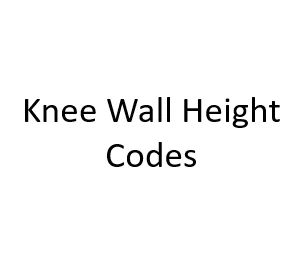In the realm of building codes and regulations, knee wall height might seem like a minor detail, but it plays a significant role in ensuring safety, functionality, and compliance within residential and commercial structures. Whether you’re a homeowner, a contractor, or someone curious about construction regulations, understanding knee wall height codes is essential. In this blog post, we’ll delve into the intricacies of knee wall height codes, exploring their purpose, significance, and how they impact various aspects of building design.
What is a Knee Wall?
Before we dive into knee wall height codes, let’s clarify what a knee wall actually is. A knee wall is a short wall, typically found in spaces with sloped roofs or attics. It’s situated between the finished living space and the angled roof, often serving as a barrier or partition. Knee walls can be found in spaces like dormers, under staircases, or even along the sides of staircases.
Importance of Knee Wall Height Codes
Knee wall height codes are established by local building authorities to regulate the dimensions and specifications of knee walls. These codes are designed with several key considerations in mind:
- Safety: Knee wall height codes ensure that knee walls are of a minimum height to prevent accidental falls. This is especially crucial in areas where knee walls are near staircases or in spaces that occupants may frequent.
- Accessibility: Compliance with knee wall height codes ensures that the space adjacent to the knee wall remains accessible and usable. Proper knee wall dimensions prevent the creation of unusable dead spaces that can’t be utilized effectively.
- Aesthetics: Knee walls often contribute to the overall aesthetics of a room or space. Following knee wall height codes ensures that these walls maintain a visually pleasing proportion in relation to the surrounding environment.
Factors Influencing Knee Wall Height Codes
Several factors influence knee wall height codes:
- Roof Pitch: The steepness of the roof’s slope impacts knee wall height. In areas with steeper pitches, knee walls might need to be higher to provide adequate headroom.
- Intended Use: The purpose of the space adjacent to the knee wall matters. If the space is meant for regular occupancy, higher knee walls might be required to ensure safety.
- Occupancy Type: Residential and commercial spaces might have different knee wall height requirements based on their intended use and occupancy load.
Calculating Knee Wall Height
Calculating knee wall height involves a few steps:
- Check Local Codes: Begin by checking your local building codes for specific requirements. These can vary from one jurisdiction to another.
- Measure Roof Pitch: Determine the pitch of the roof. This is usually expressed as a ratio (e.g., 6:12) or an angle (e.g., 30 degrees).
- Calculate Minimum Height: Using the roof pitch and other relevant factors from local codes, calculate the minimum required height for the knee wall. This ensures that anyone standing near the knee wall has sufficient headroom.
Design Considerations
While adhering to knee wall height codes is essential, it’s also important to consider the overall design and functionality of the space:
- Maximize Space: Design knee walls with consideration for the usable space they enclose. Avoid excessive heights that create awkward or unusable areas.
- Ventilation: If the knee wall encloses an attic space, consider ventilation requirements to prevent moisture buildup and ensure proper airflow.
- Aesthetic Integration: Incorporate the knee wall seamlessly into the overall design of the room or space. This can involve choosing appropriate finishes, materials, and colors.
Case Study: Knee Wall Height in Residential Design
To provide a practical perspective on the importance of knee wall height codes, let’s delve into a case study involving residential design.
Scenario: Attic Conversion
Imagine a homeowner, Sarah, who decides to convert her attic into a cozy guest bedroom. The attic has a sloped roof, which means there will be knee walls along the sides to define the space. Sarah is excited about the project but realizes she needs to ensure that the knee walls adhere to the relevant building codes.
Step 1: Researching Local Codes
Sarah starts by researching her local building codes. She discovers that the knee wall height requirements depend on the roof pitch and the intended use of the space. She finds out that for habitable spaces like bedrooms, the knee wall must have a minimum height to ensure safe occupancy.
Step 2: Measuring Roof Pitch
Sarah measures the pitch of her attic’s roof. It turns out to be 8:12, which indicates a moderately steep slope. She notes that steeper pitches usually require higher knee walls for adequate headroom.
Step 3: Calculating Knee Wall Height
Using the information from her local codes and the roof pitch, Sarah calculates the minimum required knee wall height. She realizes that if the knee wall is too low, it could result in a cramped and uncomfortable space. On the other hand, if it’s too high, it might create an awkward dead space.
Step 4: Balancing Aesthetics and Functionality
As Sarah plans the design of the attic guest room, she considers how the knee walls will impact the overall aesthetics. She chooses finishes that complement the room’s color scheme and decor. She also ensures that the knee walls integrate seamlessly with the rest of the space.
Step 5: Construction and Inspection
Once the design is finalized, Sarah hires a contractor to carry out the conversion. The contractor follows the calculated knee wall height, ensuring that the guest room is safe and comfortable. After the construction is complete, the local building inspector conducts an inspection to verify that the knee walls meet the required codes.
Conclusion of the Case Study
In this case study, Sarah’s attic conversion project illustrates the practical application of knee wall height codes in residential design. By understanding and adhering to these codes, Sarah not only creates a beautiful and functional guest room but also ensures the safety and comfort of anyone who will occupy the space.
Final Thoughts
Knee wall height codes might be one of the lesser-known aspects of building regulations, but they hold significant importance in construction and design. From safety to accessibility to aesthetics, knee wall height plays a multifaceted role in shaping the spaces we inhabit. Whether you’re planning a renovation, designing a new home, or simply curious about the world of construction, taking the time to understand and comply with knee wall height codes will lead to more thoughtful and well-designed spaces. So, the next time you encounter a knee wall, you’ll have a deeper appreciation for the meticulous considerations that went into its design and construction.


Along with every little thing which appears to be building inside this particular area, a significant percentage of opinions are generally quite exciting. Nevertheless, I appologize, because I can not give credence to your entire suggestion, all be it exhilarating none the less. It seems to everybody that your remarks are not entirely validated and in actuality you are generally your self not completely confident of your argument. In any case I did appreciate examining it.